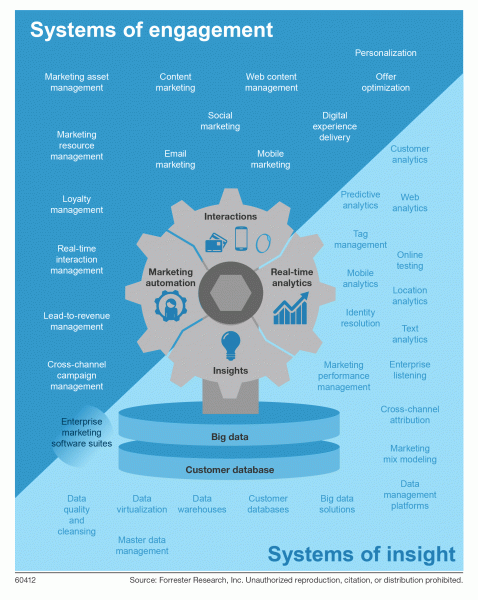B2B Marketing Technology’s End Goal? Contextual Marketing!
I attended the "Galvanize" conference sponsored by Bulldog Solutions last week and had the pleasure of hearing Scott Brinker explore the changing landscape of marketing technology. Investment in new marketing start ups and ideas is clearly at an all time high, as one look at the ChiefMarTec supergraphic will show. This is both good and bad for B2B marketers.
Good: so many technology options make marketing an exciting place to work and to deliver more impact on the business. Bad: wow, that's a lot of stuff to worry about investing in.
My colleague Rusty Warner recently published a report (subscription required) that can bring some clarity to B2B CMOs and marketing technologists thinking about technology investments as we move into 2016.
By breaking the marketing technology landscape into two basic categories — systems of insight and systems of engagement — the report both organizes an increasingly complex technology landscape and gives concrete examples of the types of solutions available to marketers today.
Most importantly, it explains why systems of insight and systems of engagement are essential to delivering contextual marketing — which Forrester defines as:
Brand-specific platform and processes that exploit customer context to deliver utility and guide the customer into the next best interaction.
In 2016, contextual marketing will become much more important to B2B marketers, especially those struggling to digitally transform their internal and customer facing processes. Unfortunately, the MarTec options available aren't likely to decrease next year as adoption continues to lag behind the technical capability available today. And new ideas continue to proliferate.
For example: I would add Through Channel Marketing Automation and Advocate Marketing as two categories of system capability that B2B marketers should consider specifically. I'm sure my new colleagues Mary Shea and Steven Wright would include a category or two under the Sales Enablement umbrella of key investments B2B marketers.
So what's a B2B marketing executive to do when deciding how to invest for future growth and success? Here are three suggestions (with credit to Rusty for his concise thinking here) to help you take stock of your enterprise marketing technology stack:
1) Inventory your current tools and wish list items. In today's complex market place, CMOs need to ensure that their teams have the right tools to meet their marketing goals, that they are using them effectively, and that tools aren't being used in silos. This is critical not only for operational and investment efficiency, but to ensure that your teams aren't wasting time duplicating effort. Marketing automation must always work toward achieving business goals. So consolidating information about all of your current — and intended — investments is a key first step.
2) Ensure you are covering both systems of insight and engagement. Aligning your marketing technology tools with Forrester's systems of insight and engagement categories will help to focus on needs and gaps more directly with business goals: Do you need to work more on understanding and operating the business? Or engaging with prospects and buyers? This breakdown can also help you identify where you can either eliminate or integrate functionality – and then begin to manage your contextual marketing capabilities more effectiely.
3) Create a shortlist of strategic vendor partnerships. Make a list of the top traits you want in your technology providers – from cultural fit to business accumen to industry expertise – and evaluate your current roster against that list. Bring your team together — and your sales and BT colleagues — to plan your future investment approach and align roles.
Above all, keep in mind that technology plays four key roles in enabling B2B marketing to: 1) unify the customer experience via end-to-end marketing processes that encompass the customer lifecycle, 2) drive faster, more effective business decision-making with customer insight, 3) enable more consistent marketing execution by transmitting data, content and insight, and 4) ease the data management burden when integrating data from operational and contextual data sources.
I am curious to hear which investment capabilities you consider most important for 2016. (Or missing from our schematic!)
Feel free to post a comment to share your thoughts here.
